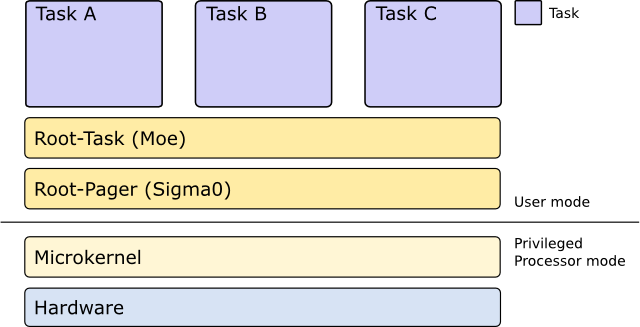 |
L4Re Operating System Framework
Interface and Usage Documentation
|
 |
L4Re Operating System Framework
Interface and Usage Documentation
|
The intention of this section is to provide a short overview about the L4Re Operating System Framework.
The general structure of a microkernel-based system will be introduced and the principal functionality of the servers in the basic environment outlined.
The L4Re Microkernel is the lowest-level component of software running in an L4Re-based system. The microkernel is the only component that runs in privileged processor mode. It does not include complex services such as program loading, device drivers, or file systems; those are implemented in user-level programs on top of it (a basic set of these services and abstractions is provided by the L4 Runtime Environment).
Microkernel services are implemented in kernel objects. Tasks hold references to kernel objects in their respective "object space", which is a kernel-protected table. These references are called capabilities. System calls to the microkernel are function invocations on kernel objects through the corresponding capabilities. These can be thought of as function invocations on object references in an object-oriented programming environment. Furthermore, if a task owns a capability, it may grant other tasks the same (or fewer) rights on this object by passing the capability from its own to the other task's object space.
From a design perspective, capabilities are a concept that enables flexibility in the system structure. A thread that invokes an object through a capability does not need to care about where this object is implemented. In fact, it is possible to implement all objects either in the kernel or in a user-level server and replace one implementation with the other transparently for clients.
The basic communication mechanism in L4-based systems is called "Inter Process Communication (IPC)". It is always synchronous, i.e. both communication partners need to actively rendezvous for IPC. In addition to transmitting arbitrary data between threads, IPC is also used to resolve hardware exceptions, faults and for virtual memory management.
The following list gives a short overview of the kernel objects provided by the L4Re Microkernel:
The system has a multi-tier architecture consisting of the following layers depicted in the figure below:

In terms of functionality, the system is structured as follows:
Lending terminology from the distributed systems area, applications offering services to other applications are usually called servers, whereas applications using those services are named clients. Being in both roles is also common, for instance, a file system server may be viewed as a server with respect to clients using the file system, while the server itself may also act as a client of a hard disk driver.
The L4Re Runtime Environment provides a basic set of services and abstractions, which are useful to implement and run user-level applications on top of the L4Re Microkernel. They form the L4Re Operating System Framework.
The L4Re Operating System Framework consists of a set of libraries and servers. L4Re follows an object-oriented design. Server interfaces are object-oriented, and the implementation is also object-oriented.
A minimal L4Re-based application needs 3 components to be booted beforehand: the L4Re Microkernel, the root pager (Sigma0), and the root task (Moe). The Sigma0 root pager initially owns all system resources, but is usually used only to resolve page faults for the Moe root task. Moe provides the essential services to normal user applications such as an initial program loader, a region-map service for virtual memory management, and a memory (data space) allocator.